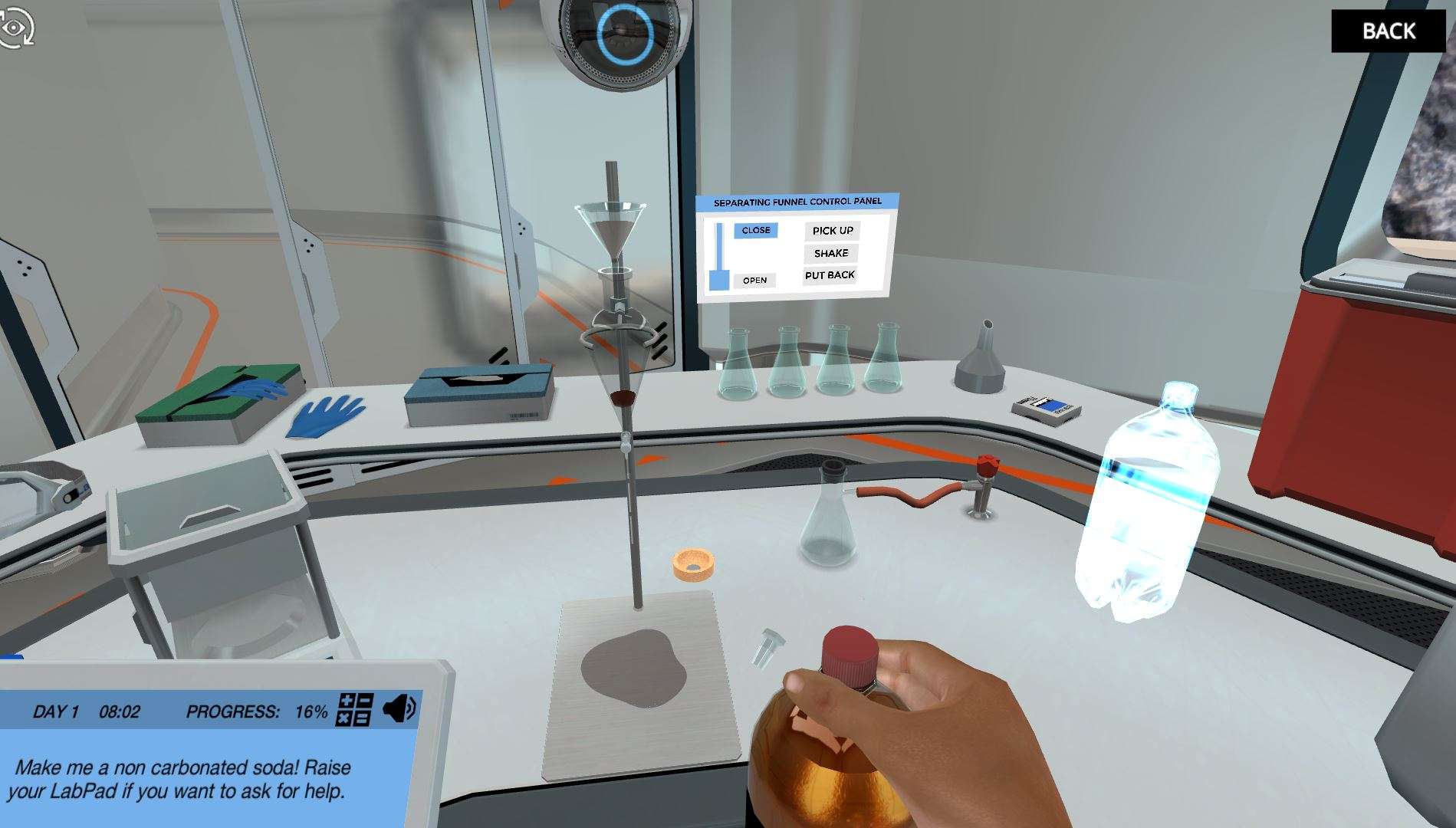Heading 1
Heading 2
Heading 3
Heading 4
Heading 5
Heading 6
Lorem ipsum dolor sit amet, consectetur adipiscing elit, sed do eiusmod tempor incididunt ut labore et dolore magna aliqua. Ut enim ad minim veniam, quis nostrud exercitation ullamco laboris nisi ut aliquip ex ea commodo consequat. Duis aute irure dolor in reprehenderit in voluptate velit esse cillum dolore eu fugiat nulla pariatur.
Block quote
Ordered list
- Item 1
- Item 2
- Item 3
Unordered list
- Item A
- Item B
- Item C
Bold text
Emphasis
Superscript
Subscript
About This Simulation
Learn how to use a separating funnel to extract and dry a water soluble compound, such as caffeine from tea or coffee. Can you also predict the liquid phases in which the compound can be found?
Learning Objectives
- Describe the extraction process and its purpose, giving examples of its applications
- Explain the fundamentals of extraction theory and describe the process on molecular and operational levels
- Explain the use of drying agents and choose an appropriate drying agent for a variety of solvents
- Confidently predict which liquid layer is which and identify the layer your product is in
- Carry out step-by-step single and multiple extractions for a variety of solvents and combinations
- Competently demonstrate practical techniques required specifically for solvent extraction by following best practice
- Troubleshoot and rectify common problems encountered in solvent extraction protocol and rotary evaporation
- Competently carry out the work up steps that follow liquid-liquid extraction to isolate a product (filtration, solvent evaporation)
About This Simulation
Lab Techniques
- Liquid-liquid extraction
- Separatory funnel
Related Standards
- Alignment pending
- Alignment pending
- Alignment pending
Learn More About This Simulation
Most students (and teachers!) can relate to caffeine's effect, either in tea or coffee. In the Liquid-Liquid Extraction simulation, you will learn how to extract caffeine as powder from its liquid form.
Master the separatory funnel
Learn the correct usage of a separatory funnel by first decanting a simple soda, removing any gas from the liquid perfection you shake, and venting the separatory funnel. This will teach you how to correctly set up the equipment while preparing you for the next steps. Next you’ll extract the caffeine, using an aqueous and organic phase to transfer the caffeine in multiple steps, from the aqueous coffee to dichloromethane.
Learn from your mistakes!
If you’ve ever made a mistake in the lab, this virtual lab has your back. Learn how to use a separatory funnel without fear of messing things up. In this simulation you have the freedom to make mistakes and learn from them as you go. And if you make a mess, don’t worry: Dr. One will be there to help clean up!
Use practice to learn theory
In liquid-liquid extractions the main focus is on using the separatory funnel. This is used here to separate caffeine from its aqueous phase into an organic phase and then dry it for a tiny amount of dried caffeine powder. Complete this task to help answer the question: Does a cup of tea contain more caffeine than a cup of coffee?
For Science Programs Providing a Learning Advantage
Boost STEM Pass Rates
Boost Learning with Fun
75% of students show high engagement and improved grades with Labster
Discover Simulations That Match Your Syllabus
Easily bolster your learning objectives with relevant, interactive content
Place Students in the Shoes of Real Scientists
Practice a lab procedure or visualize theory through narrative-driven scenarios


FAQs
Find answers to frequently asked questions.
Heading 1
Heading 2
Heading 3
Heading 4
Heading 5
Heading 6
Lorem ipsum dolor sit amet, consectetur adipiscing elit, sed do eiusmod tempor incididunt ut labore et dolore magna aliqua. Ut enim ad minim veniam, quis nostrud exercitation ullamco laboris nisi ut aliquip ex ea commodo consequat. Duis aute irure dolor in reprehenderit in voluptate velit esse cillum dolore eu fugiat nulla pariatur.
Block quote
Ordered list
- Item 1
- Item 2
- Item 3
Unordered list
- Item A
- Item B
- Item C
Bold text
Emphasis
Superscript
Subscript
A Labster virtual lab is an interactive, multimedia assignment that students access right from their computers. Many Labster virtual labs prepare students for success in college by introducing foundational knowledge using multimedia visualizations that make it easier to understand complex concepts. Other Labster virtual labs prepare learners for careers in STEM labs by giving them realistic practice on lab techniques and procedures.
Labster’s virtual lab simulations are created by scientists and designed to maximize engagement and interactivity. Unlike watching a video or reading a textbook, Labster virtual labs are interactive. To make progress, students must think critically and solve a real-world problem. We believe that learning by doing makes STEM stick.
Yes, Labster is compatible with all major LMS (Learning Management Systems) including Blackboard, Canvas, D2L, Moodle, and many others. Students can access Labster like any other assignment. If your institution does not choose an LMS integration, students will log into Labster’s Course Manager once they have an account created. Your institution will decide which is the best access method.
Labster is available for purchase by instructors, faculty, and administrators at education institutions. Purchasing our starter package, Labster Explorer, can be done using a credit card if you are located in the USA, Canada, or Mexico. If you are outside of North America or are choosing a higher plan, please speak with a Labster sales representative. Compare plans.
Labster supports a wide range of STEM courses at the high school, college, and university level across fields in biology, chemistry, physics, and health sciences. You can identify topics for your courses by searching our Content Catalog.















